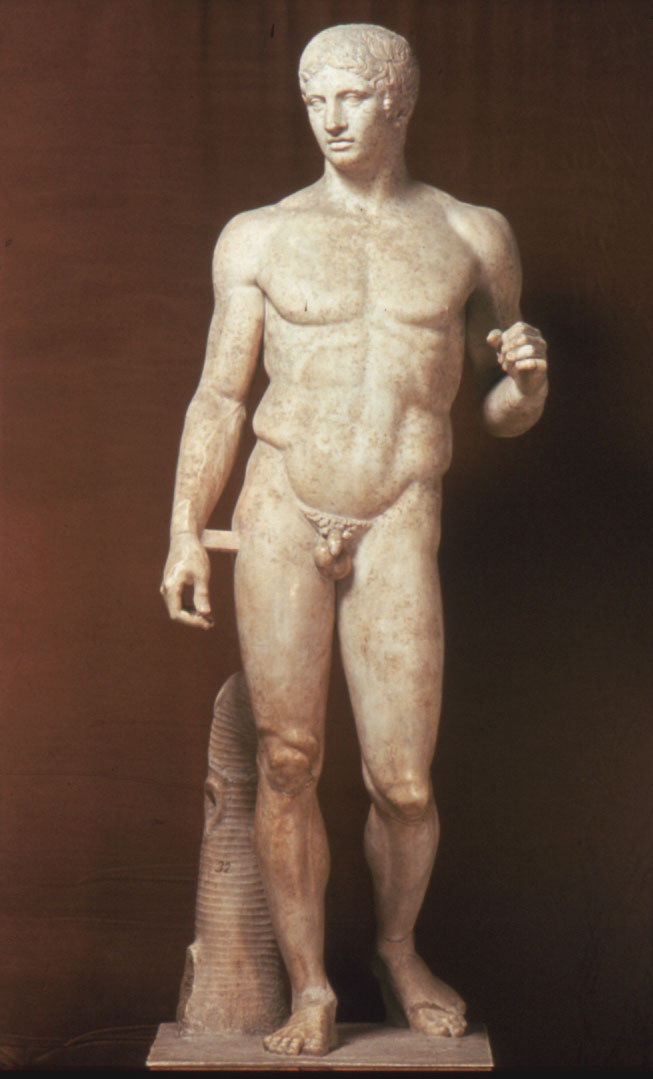Contraposto
In real life, we almost never stand with our weight evenly divided on both feet. We're usually leaning more weight to one side, which makes the knee on the standing leg a bit higher, and the hip on the standing leg stick out a bit to the side. When a sculptor takes this uneven division of weight into account in his/her work, we say that the sculpture is standing in "contraposto". Check out, for example, this guy:

Polycleitos, Canon (today called Spear Bearer) roman copy of original from 450-440 BC (Naples Museum)
Contraposto perfected! His right leg holds the majority of his weight, and you can see just beautifully how it tips the rest of his body ever so slightly. Greek classical sculptors, like Polycleitos, were obsessed with achieving naturalness in posture, and ideal beauty in bodily form. Does this sculpture seem natural and beautiful to you?
Contraposto can be even more clearly demonstrated by looking at a sculpture not standing in contraposto. For that, we turn to an example from ancient Egypt:
Artist Unknown, Menkaure and Khamerernebty, 2490-2472 BC (Boston Museum of Fine Arts)
Although King Menkaure has one foot farther in front of the other, as if he is striding powerfully forward, his body is highly symmetrical, his shoulders, hips and knees even. Like the classical Greek figure, these two are highly idealized, but because they are not standing in contraposto, they look less in-this-world than our Greek friend, more formalized.
So next time you see a statue of a standing figure, stop and notice whether or not it is standing in contraposto. If it is, does it help the statue seem more natural? If it doesn't, does the statue strike you as distant and formal?
P.S. That Egyptian statue is from 2490 BC!!! The idea that a sculpture that complex with that much meaning behind it could have been created 4500 years ago thrills me.
I think the Greek statue is 'prettier'. Do you think that is because the Western world based their canon of beauty off classical greek statues or do you think that it is 'prettier' because it is more natural (a better representation of ourselves)?
ReplyDeleteYou have a great point that our opinions are greatly (often subconsciously) influenced by what norms our culture and our history have developed. I suspect many people may find the Greek sculpture more pretty because it has been placed on a pedestal (pun intended) by Western Art History as an ideal of beauty, while Egyptian sculpture has been relegated more to the realm of exotic curiosity.
DeleteI don't think most people see something more natural as always necessarily prettier. Can you think of some examples where a very unnatural representation is generally considered to be very beautiful? In trying to come up with a good example, I went to the Musee d'Orsay website and clicked on works in focus, sculpture. Here is a work by Rodin which most of us probably perceive as pretty, but which gets its beauty and power from the combination of realism and abstraction (a head coming out of a rock). See what you think: http://www.musee-orsay.fr/en/collections/works-in-focus/sculpture.html?no_cache=1&zoom=1&tx_damzoom_pi1%5BshowUid%5D=2321
I love the way the Egyptian queen is holding up the king; almost like she is keeping him balanced, physically and also emotionally. She looks more grounded than he, secure and proud of her important role. Ironically, to me the Greek statue has more flow but less emotion.
ReplyDeleteGreat point! We humans can have a strong emotional reaction to abstracted works. And the Egyptian king and queen do seem like they are fiercely together.
DeleteAnother point about contraposto is that the shoulders are tilted in the opposite direction as the hips.
ReplyDeleteVery true! Thanks for the addition.
Delete